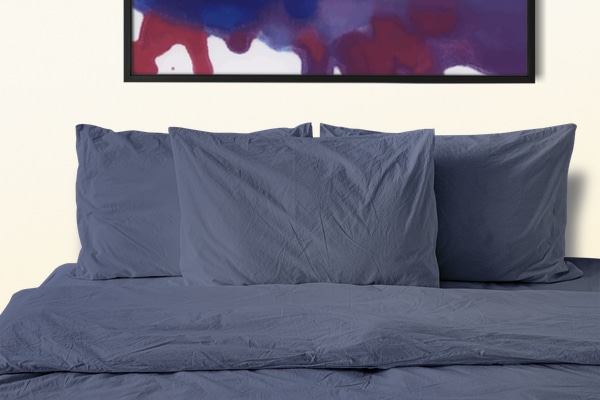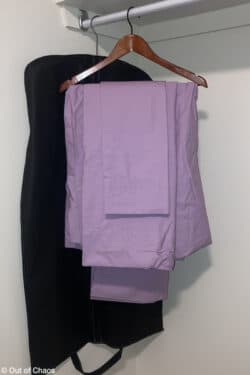
It’s a common scenario in many houses. Homeowners root and rummage through overstuffed linen closets and cram-packed bins, trying to find the sheets, blankets, and duvets they need. Often when I do residential organizing, my clients ask how many sets of bedding they need. My answer is always, “It depends.” It depends on what types of bedding you like and how often you do laundry.
Declutter Sheets and Sheet Sets
Start with decluttering sheets that don’t fit any of the beds you currently have. If you don’t have double beds, take those sheets out of your closet. Next, remove sheets that no longer fit your lifestyle. If your kids are in their late teens, you probably let go of the cartoon character bedding. If you live in a warm climate, donate your polar fleece sheets.
Choose two or three sets for each bed. (Here’s a bed sheet size guide in case you need to measure your sheets). My suggestion is that if you do laundry regularly, you may only need two sets – one on the bed and one spare. If you use a laundromat, you may wish to have three sets – one on the bed, one in the laundry, one clean in the cupboard. That being said, if you enjoy sleeping on flannel or fleece sheets in the winter and cotton in the summer, you may opt to keep two sets of each type (a total of 4 sets) for each bed you regularly use. In a pinch, you can use off-season bedding on your bed until you wash the sheets you need.
If you have young children prone to having “accidents,” keep 3-4 sheet sets for each bed. For guest rooms, I recommend you keep two sets per bed or one set for each season. If you enjoy fresh pillowcases, feel free to keep one or two extra sets per bed.
Organize and Store Your Sheets

If you don’t have a linen closet, you can store bedding in the room where you will use it. Wheeled totes are useful for under-the-bed storage because you can move them around easily. Plus, they are transparent so you can see the contents, and the lid keeps them dust-free. You can also hang them on a sturdy hanger covered with a garment bag.
Blankets and Duvets
Depending on the climate where you live, you will probably only need one or two blankets per bed. If you prefer a duvet, have at least two duvet covers – one on the bed and one spare. If your duvet is dry-clean-only, keep a couple of blankets in case of emergency because your duvet might be a couple of days at the cleaners.
Again, if you have children, keep a few spare blankets in case of accidents. You might also want to keep a couple of extra blankets in an emergency preparedness kit, near your first-aid kit, and in the trunk of your car (especially in winter driving conditions).
Pillows
A good night’s sleep is essential, so consider good quality pillows to be an investment in your future health. According to the National Sleep Foundation (USA), if your pillows are more than a few years old, it might be time to replace them. Declutter old, smelly, and lumpy pillows. Keep the best ones and clean them properly. Purchase some pillow protectors to extend their lifespan.
Where to Donate Excess Sheets, Blankets, etc.
There are quite a few agencies around the Lower Mainland that accept clean, good-quality bedding. You can donate stained or slightly damaged clean sheets and blankets to animal shelters. Check our Where to Sell or Donate Items page for a list of agencies that may accept your linens.
If you need some hands-on help liberating your linen closet, contact the Out of Chaos team through our website.
Image by rawpixel.
